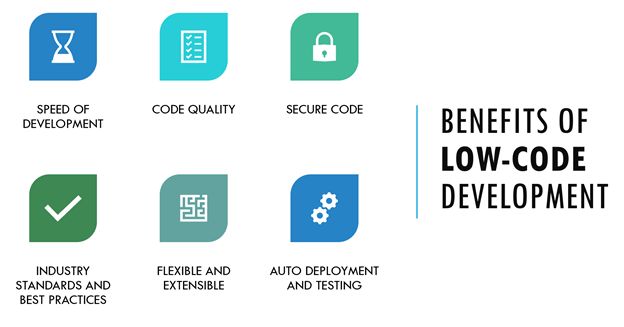Excellent Info To Choosing Low-Code Platform Recommendations
Wiki Article
In Terms Of The Integration Capabilities, Low-Code Development Of Applications Has Numerous Advantages.
Low-code integration of applications has many advantages, including the capability to seamlessly integrate different systems and services. Here are the benefits of pre-built APIs and connectors:
Wide Variety of Connectors Low-code software typically includes an array of connectors that are pre-built for the most popular enterprise applications (e.g. CRMs, databases ERPs, cloud-based services, and more). It simplifies the integration with these systems.
API Integration: Many platforms provide out-of-the-box API integration features. This allows developers to effortlessly connect with data from other sources and services.
Usability:
Drag-and-Drop Interfaces: A variety of integration tasks are easily completed using drag-and–drop interfaces. This makes it feasible for developers and other non-developers alike to build complex systems without extensive coding.
Visual Workflow Creators: The graphic tools used to create workflows and data flows makes it easier for users to understand the integration process.
Standardized Integration Methods:
SOAP and RESTful Service The support for web services standards like SOAP and REST allows easy integration with many other systems.
OData Standards: OData standards allow for the easy manipulation and access of data across various platforms and applications.
Real-Time Data Synchronization:
Real-Time Integrations: Lowcode platforms handle data synchronization in real-time between the system and applications making sure that data is up-to-date and consistent across an company.
Event-Driven Architecture: Certain platforms can support event-driven architectures. enabling applications to respond to events in real-time. This is vital for dynamic and interactive applications.
Legacy System Integration:
Connecting old and new Systems: Low-code platforms often provide tools to integrate with older systems, which allows organizations to modernize their IT infrastructure without having to completely revamp the existing system.
Data Migration Tools Built in data-migration tools allow you to move data from old systems to applications that use low-code.
Third-Party Services Integration:
Integration with Cloud Services: Seamless integration with cloud-based services like AWS, Azure, and Google Cloud allows for the simple deployment and scaling of applications.
Integration of Business Applications Lowcode platforms are used to integrate different business applications like Salesforce, SAP, Microsoft Dynamics etc. to create a seamless workflow that spans different functions of business.
Data management simplified:
Unified Data models: Certain low-code platforms provide unified data models that makes data integration and management across various platforms.
Data Connectors are data connectors that have been pre-configured that provide rapid access to sources of data, and allow manipulation.
Security and Compliance
Low-code integration platforms meet security standards to safeguard the data during transport or in storage.
Security Features: These platforms typically contain features that ensure the integrations are compliant with the requirements of regulatory agencies (e.g. GDPR, HIPAA), providing peace of mind for businesses dealing with sensitive data.
Extensibility:
Custom Code and Scripts Low-code platforms can often be able to support more complex integrations by allowing the inclusion of scripts and custom codes. This allows for greater flexibility without sacrificing ease of usage.
Plug-in Ecosystem A collection of plugins and extensions can increase the capabilities of integration that allow users to include additional functions as they need.
Overall, integration capabilities within low-code applications development platforms allow them to function as a strong platform to create integrated and scalable, efficient and connected applications. They make it easier to connecting different systems, improve data flow and allow enterprises to embrace new technologies while using existing ones. Take a look at the best Low-code Platform for application development for blog examples including application development platforms, app development platform, push notifications android, develop mobile application, lowcode no code, develop web app, microsoft azure sql, jdbc server, developing mobile apps, azure sql databases and more.

Low-Code App Development Has Many Benefits In Terms Of Cost-Effectiveness.
Low-code development offers a number of advantages in terms of cost-effectiveness. Companies looking to optimize budgets can take advantage of this method while still delivering high-quality applications. These are the major benefits reduced costs for development:
Lower requirements for coding: Low code platforms eliminate the need for lengthy, hand-coded applications. Developers can take less time and energy developing applications. This means lower cost of labor.
Reduced Developer Resources: Because low-code is quicker and easier to develop, less specialized developers will be required. This can reduce hiring and personnel costs.
Speedier Time to Market
Accelerated Development: Low-code platforms offer visually-based development tools, components that are pre-built and other tools that allow rapid development of software. Businesses can introduce their products to the market much faster. This can lead to faster revenue generation and better positioning in the market.
Rapid Prototyping: Businesses can develop and test prototypes in a very short amount of time, which decreases the amount of time required to develop. This allows them to make faster prototypes after receiving feedback from users.
Reduce Maintenance Costs
Simplified Maintenance: Applications built with low-code platforms are typically easier to maintain due to their modular components and standard architecture. This reduces the cost of maintenance on a regular basis.
Automated Updates Many low-code platforms can be adapted to handling updates and patches in a way that is safe and efficient. This eliminates the need for manual intervention.
Efficient Resource Utilization:
Low-code platform contributions allow both business users and other non-developers participate in the process of creating. This democratization of development processes enables businesses to utilize the skills and expertise of a greater variety of employees.
IT Departments can Focus on Strategic Initiatives instead of being caught up in routine tasks of development, IT departments are able concentrate their efforts on strategic initiatives that increase the efficiency and productivity of their departments.
Scalable pricing models:
Subscription-Based Price: Many low-code platforms have flexible subscription-based pricing that scales depending on use. This allows businesses to match spending to actual requirements and growth, while avoiding huge up-front costs.
Pay-as-you go options: Some platforms provide pay-as-you-go options, ensuring that businesses only pay for the services they use and can be especially beneficial for startups and small companies with limited funds.
Reduction in Third-Party Software Fees:
Built-in Functionalities: Low code platforms are equipped with a wide range of built-in features and integrations, which reduce the need for third-party tools and software. Subscription fees and licensing costs are also cut down.
Pre-Built Integrations: The possibility of having pre-built integrations with the most popular services and systems reduces the need for custom-designed development. Savings on both time as well as cash.
Increased ROI
A faster return on investment: Combining rapid development with lower costs and a quicker time to market, companies can achieve an increased return on their investment (ROI).
Increased agility. Businesses are able to quickly adjust to market changes and customer requirements to ensure they are relevant. They can also profit from new business opportunities as they occur.
Train for More for
User-friendly interfaces: Low-code platforms have intuitive and user friendly interfaces that cut down on the learning curve. They also minimize the requirement for long-running training programs.
Accessible Resources: Many platforms that use low-code offer extensive instructional materials, tutorials, and support for community members. This eliminates the need for formal education and costs associated with it.
Collaboration Streamlined:
Enhanced collaboration tools Collaboration tools are integrated into the workflow. This allows more effective communication between team members and the reduction of project overhead.
Unified Development Environment. A single unifying software development environment can streamline processes and reduce the cost and complexity of managing multiple platforms and tools.
Low-code development is cost-effective since it reduces development and maintenance expenses. It also accelerates time to market and optimizes the use of resources. Pricing models can be adapted. These factors provide substantial economic benefits to companies. Low-code is a fantastic option for companies that wish to increase budgets while still being able to create robust, scalable and high-quality software. Take a look at the top https://www.wavemaker.com/low-code-enterprise-application-development-platform/ for site advice including paas service, rapid app development, application modernization, application development platforms, push alerts, application development platforms, build with docker, application modernisation, microsoft azure sql, app dev platform and more.

In Terms Of Vendor Support And Community Support, Low-Code Application Development Can Bring Many Advantages.
Low-code development platforms for applications can be an excellent method to gain support from the vendor as well as community involvement. Both are crucial to ensure the success of your implementation as well as ongoing maintenance of the application. Here are a few major benefits: Support from vendors
Comprehensive Technical Support:
Support Teams Dedicated to You A lot of low-code platforms have special support teams that are able to assist in technical problems, problem solving and provide guidance. This helps ensure that any problems are quickly addressed.
Help is accessible 24/7. A lot of vendors offer 24/7 support that can be especially beneficial for companies that operate in different time zones.
Onboarding and Training:
Training programs that are structured: Vendors offer structured training courses, such as webinars or certification courses. This helps users to quickly get to grips with the platform.
Personalized Onboarding : A lot of providers offer customized onboarding which assist new customers implement the platform and customize it to suit their particular needs.
Updates and Enhancements, Regularly and Enhancements:
Continuous Improvement : Low-code platforms manufacturers often release regular updates which include new features as well as performance improvements and security patches. These updates ensure that their platform stays up to date and secure.
Feedback Integration: Vendors incorporate feedback from their users into their design cycles to ensure the platform is constantly evolving to meet the ever-changing needs of its users.
Comprehensive Documentation:
Documentation: A detailed documentation is offered for all products. It includes everything from basic to advanced customization. This can help users find solutions on their own.
API References API documentation can assist developers customize and integrate applications using the Low-Code platform.
Professional Services and Consulting
Expert Consulting: Most vendors offer consulting services to help with architectural planning, strategic planning, and complex implementations. This assists users to make the most of their software's capabilities.
Custom Development Services A few companies offer customized development services to develop specific functions and integrations that are not included in standard.
Community Support
Active User Communities
Forums and Discussion boards Forums and Discussion boards: Many low-code platforms provide vibrant online communities for users to discuss ideas, ask questions, and collaborate.
Virtual and local User Groups These groups give you the chance to network, learn and share experiences.
Knowledge Sharing and Collaboration
Community-Contributed Resources: Users often share templates, modules, and extensions that they have developed, which can be reused or adapted by others, accelerating development and innovation.
Crowdsourced Solution Finding: The collective experience and wisdom of a group can be an excellent resource for solving complex issues.
Learning and Development
Community-Led Learning: Several communities host workshops, training sessions, and webinars which are typically led by users with experience who can provide insights and techniques that are more advanced.
Online Courses and tutorials: Community members often create and distribute online tutorials, courses, and how-to guide, improving the learning resources for all users.
Feedback and Influence
Product Feedback: Several community forums offer channels to give feedback to vendors. This could influence the development of new features and improvements.
Beta Testing Active communities might be eligible to take part. This gives them early access and to be involved in the design of the platform.
Recognition and encouragement:
A lot of companies offer community recognition programs. These programs reward active community members, and can include MVP programs.
Peer Support: Members of the community typically provide peer support by sharing their knowledge and offering guidance to less experienced users creating a more collaborative and supportive environment.
Overall, the combination of a robust vendor's support and a lively, active community offer a robust support system for low-code app development. It ensures that the users are able to access the resources as well as the expertise and collaboration opportunities to create, deploy, and maintain their apps, ultimately enhancing efficiency and creativity.
